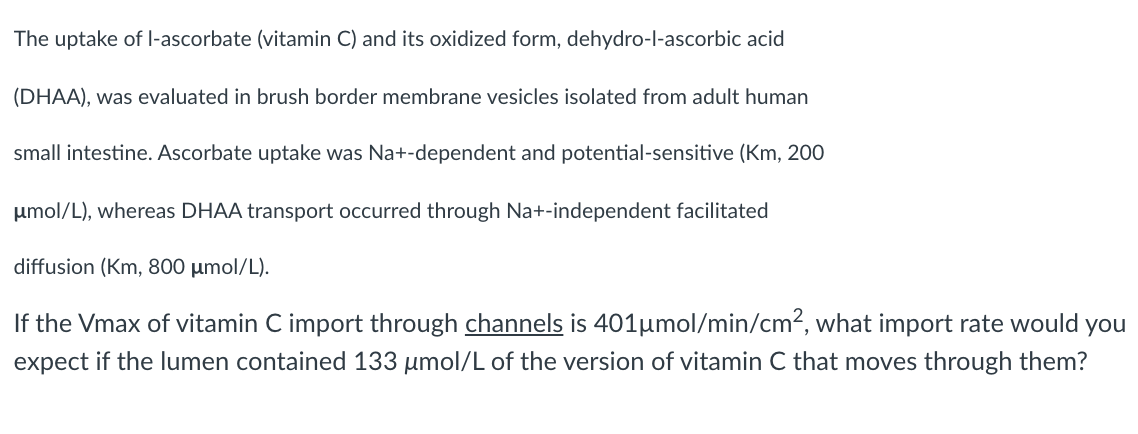The uptake of l-ascorbate (vitamin C) and its oxidized form, dehydro-l-ascorbic acid (DHAA), was evaluated in brush border membrane vesicles isolated from adult human small intestine. Ascorbate uptake was Na+-dependent and potential-sensitive (Km, 200 umol/L), whereas DHAA transport occurred through Na+-independent facilitated diffusion (Km, 800 µmol/L). If the Vmax of vitamin C import through channels is 401µmol/min/cm², what import rate would |you expect if the lumen contained 133 µmol/L of the version of vitamin C that moves through them?
Enzyme kinetics
In biochemistry, enzymes are proteins that act as biological catalysts. Catalysis is the addition of a catalyst to a chemical reaction to speed up the pace of the reaction. Catalysis can be categorized as either homogeneous or heterogeneous, depending on whether the catalysts are distributed in the same phase as that of the reactants. Enzymes are an essential part of the cell because, without them, many organic processes would slow down and thus will affect the processes that are important for cell survival and sustenance.
Regulation of Enzymes
A substance that acts as a catalyst to regulate the reaction rate in the living organism's metabolic pathways without itself getting altered is an enzyme. Most of the biological reactions and metabolic pathways in the living systems are carried out by enzymes. They are specific for their works and work in particular conditions. It maintains the best possible rate of reaction in the most stable state. The enzymes have distinct properties as they can proceed with the reaction in any direction, their particular binding sites, pH specificity, temperature specificity required in very few amounts.

Cell membrane or plasma membrane is a phospholipid bilayer and is selectively permeable. Small, nonpolar solutes freely pass across the membrane, down their concentration gradient. The hydrophobic phospholipid bilayer prevents the passage of large, polar and charged solutes across it. Passage of these large and polar solutes is facilitated by special proteins.
The mechanisms by which solutes cross the membrane are called membrane transport mechanisms. These mechanisms can be divided into two major categories - passive transport and active transport. Passive transport is transport of solutes without any energy expenditure. Active transport is energy-dependent transport of solutes.
Passive transport can be through simple diffusion or facilitated diffusion. Simple diffusion is unassisted movement of solutes across the membrane down their concentration gradient. No protein is needed for simple diffusion; solutes just diffuse through the phospholipid bilayer. Facilitated diffusion is movement of a solute across the membrane down its concentration gradient, with the help of a carrier or channel protein. Solutes that cannot cross the hydrophobic phospholipid bilayer have to move down their concentration gradient across the membrane with the help of carrier or channel proteins.
During active transport, solutes are moved against their concentration gradient. This requires expenditure of energy. The energy is generally provided by ATP hydrolysis. Active transport across the membrane usually makes use of carrier proteins.
Trending now
This is a popular solution!
Step by step
Solved in 3 steps









